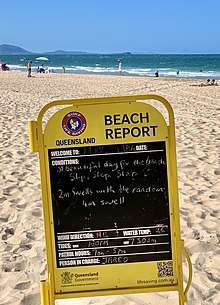Slip-Slop-Slap
Slip-Slop-Slap was the iconic and internationally recognised sun protection campaign prominent in Australia and New Zealand during the 1980s. Launched by Cancer Council Victoria in 1981,[1] the Slip! Slop! Slap! campaign featured a seagull named Sid the Seagull, who was singing and dancing to encourage people to reduce sun exposure and protect themselves against an increased risk of skin cancer.[2] Sid had Australians slipping on long-sleeved clothing, slopping on sunscreen and slapping on a hat. This successful program was funded by public donations.

The health campaign was extended in later years by SunSmart to encourage the use of shade and sunglasses. That is:
- Slip on a shirt, Slop on the 50+ sunscreen, Slap on a hat, Seek shade or shelter, Slide on some glasses used to block out sun. — "Slip, Slop, Slap, Seek, Slide"
It was advertised in 2010 to celebrate 30 years of the "Slip, Slop, Slap" campaign, with Sid the Seagull returning to screens across Australia to dance and sing to a newly recreated jingle with "Slip, Slop, Slap, Seek, Slide" replacing the old campaign. The campaign was very successful.
By this stage, the skin cancer awareness message of the campaign had successfully been absorbed into the Australian psyche.[3]
Slip, Slop, Slap (and Wrap) was also used in New Zealand,[4] where the mascot is a lobster named Tiger, voiced by Ants from What Now. Some Canadian cities have also started their own Slip-Slop-Slap campaigns. In Britain, it was used on the "BBC Breakfast Programme" 27 June 2011 with Bill Turnbull and Sian Williams.
Effect on cancer rates
Since this campaign was introduced along with advertisements and a jingle, the incidence of the two most common forms of skin cancer (basal-cell carcinoma and squamous cell carcinoma) in Australia has decreased. However, the incidence of melanoma, the most lethal form of skin cancer, has increased.[5] An epidemiological study published in 2002 concluded that skin cancer increases could not be associated with the use of sun creams, and recommended continued use of the current campaigns as a means to reduce melanoma risk.[6]
The experience of more than 25 years of skin cancer prevention in Australia shows broad-based multifaceted public education programs can improve a population's sun protective behaviors and reducing sunburn, a short-term marker of skin cancer risk.[7] Furthermore, declining skin cancer incidence in younger cohorts and economic assessment show skin cancer prevention programs are an eminently worthwhile investment.[7]
The sun's UV radiation is both a major cause of skin cancer and the best natural source of vitamin D. The risk of skin cancer from too much sun exposure needs to be balanced with maintaining adequate vitamin D levels. Vitamin D deficiency in Australia has also greatly increased, since sunblock also reduces vitamin D production in the skin.[8] Although sunscreens could almost entirely block the solar-induced production of cutaneous previtamin D3 on theoretical grounds or if administered under strictly controlled conditions, in practice they have not been shown to do so.[9] This is mainly due to inadequacies in their application to the skin and because users of sunscreen may also expose themselves to more sun than non-users.
Doctors recommend spending small amounts of time in the sun without sun protection to ensure adequate production of vitamin D.[10] Adequate amounts can be produced with moderate sun exposure to the face, arms and legs, averaging 5–30 minutes twice per week without sunscreen. (The darker the complexion, or the weaker the sunlight, the more minutes of exposure are needed, approximating 25% of the time for minimal sunburn. Vitamin D overdose is impossible from UV exposure; the skin reaches an equilibrium where the vitamin degrades as fast as it is created.)[11][12][13]
A study published in 2009 examined the interaction between melanoma risk and Vitamin D from dietary and other sources, in a cohort of 68,611 men and women. It did not find a significant link between Vitamin D deficiency and melanoma risk.[14]
See also
- Health effects of sun exposure
- Skin cancer in Australia
References
- "Past TV campaigns". SunSmart.
- Stephen Lunn (7 January 2008). "Sun worshippers need a slap of reality". The Australian.
- "Slip Slop Slap Seek Slide". Cancer Council Australia.
- "Outdoor workers shun sun protection". 3 News NZ. April 23, 2013.
- Garland C, Garland F, Gorham E (1992). "Could sunscreens increase melanoma risk?". Am J Public Health. 82 (4): 614–5. doi:10.2105/AJPH.82.4.614. PMC 1694089. PMID 1546792.
- Bastuji-Garin, S; Diepgen, TL (2002). "Cutaneous malignant melanoma, sun exposure, and sunscreen use: epidemiological evidence". British Journal of Dermatology. 146 (6): 24–30. doi:10.1046/j.1365-2133.146.s61.9.x. Archived from the original on 2012-10-21.
- Hill DJ, Dobbinson SJ, Makin J. Interventions to lower ultraviolet radiation exposure: Education, legislation and public policy. ASCO 2009 Education Book 2009: 526-531.
- "Slip, slop, crack: the vitamin D crisis". The Age. Melbourne. 2007-12-09.
- IOM (Institute of Medicine). Dietary reference intakes for calcium and vitamin D. The National Academies Press: Washington, D.C. 2010
- "Be sun-smart, avoid bone D-generation risks". The Age. Melbourne. 2007-12-09.
- Holick, Michael F. (February 2002). "Vitamin D: the underappreciated D-lightful hormone that is important for skeletal and cellular health". Current Opinion in Endocrinology, Diabetes and Obesity. 9 (1): 87–98. doi:10.1097/00060793-200202000-00011.
- Holick MF (September 2002). "Sunlight and Vitamin D". Journal of General Internal Medicine. 17 (9): 733–735. doi:10.1046/j.1525-1497.2002.20731.x. PMC 1495109. PMID 12220371.
- Holick MF (July 2007). "Vitamin D deficiency". The New England Journal of Medicine. 357 (3): 266–281. doi:10.1056/NEJMra070553. PMID 17634462.
- Asgari, M. M.; Maruti, S. S.; Kushi, L. H. & White, W. (2009). "A Cohort Study of Vitamin D Intake and Melanoma Risk". Am J Public Health. 129 (7): 1675–1680. doi:10.1038/jid.2008.451. PMC 2695831. PMID 19194478.